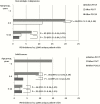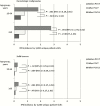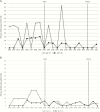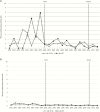Trends in Invasive Pneumococcal Disease in Cancer Patients After the Introduction of 7-valent Pneumococcal Conjugate Vaccine: A 20-year Longitudinal Study at a Major Urban Cancer Center
- PMID: 29020313
- PMCID: PMC5850633
- DOI: 10.1093/cid/cix739
Trends in Invasive Pneumococcal Disease in Cancer Patients After the Introduction of 7-valent Pneumococcal Conjugate Vaccine: A 20-year Longitudinal Study at a Major Urban Cancer Center
Abstract
Background: Rates of invasive pneumococcal disease (IPD) declined since routine childhood immunization with the 7-valent pneumococcal conjugate vaccine (PCV7) in 2000. We studied the impact of PCV7 on the incidence of IPD in cancer patients.
Methods: This was a retrospective analysis of adult and pediatric patients treated at Memorial Sloan Kettering Cancer Center from 1992 to 2012. Recovery of Streptococcus pneumoniae from a sterile site defined IPD. IPD incidence was calculated as cases per 1,000 unique patient-visits per year (UPV). IPD incidence was calculated for the periods: "before PCV7" (1992-2000), "after PCV7" (2001-2010) and "after PCV13" (2011-2012).
Results: Of 343 IPD cases, 165, 155, and 23 cases occurred "before PCV7," "after PCV7" and "after PCV13" respectively. The IPD incidence declined from 0.43 "before PCV7" to 0.17 "after PCV7" (95% confidence interval [CI]: 0.33-0.46, P < .001) and 0.11 "after PCV13" (95% CI: 0.42-0.96, P = .004). Adults with hematologic malignancies and children had the highest incidence. In patients 1-4 years old, the incidence declined from 11.2 "before PCV7" to 2.38 "after PCV7" (79% decrease, 95% CI: 0.1-0.4, P < .001). In patients with hematologic malignancies, the incidence declined from 2.55 "before PCV7" to 0.92 "after PCV7" (64% decrease, 95% CI: 0.27-0.47, P < .001).
Conclusions: The incidence of IPD among cancer patients sharply declined after introduction of PCV7; especially in high risk groups. The decline in adults suggests an indirect effect from PCV7 childhood vaccination.
Keywords: cancer; invasive pneumococcal disease; pneumococcal conjugate vaccine.
© The Author 2017. Published by Oxford University Press for the Infectious Diseases Society of America. All rights reserved. For permissions, e-mail: journals.permissions@oup.com.
Figures





References
-
- Shigayeva A, Rudnick W, Green K et al. ; Toronto Invasive Bacterial Diseases Network Invasive pneumococcal disease among immunocompromised persons: implications for vaccination programs. Clin Infect Dis 2016; 62:139–47. - PubMed
-
- Wong A, Marrie TJ, Garg S, Kellner JD, Tyrrell GJ; SPAT Group Increased risk of invasive pneumococcal disease in haematological and solid-organ malignancies. Epidemiol Infect 2010; 138:1804–10. - PubMed
-
- Kyaw MH, Rose CE Jr, Fry AM et al. ; Active Bacterial Core Surveillance Program of the Emerging Infections Program Network The influence of chronic illnesses on the incidence of invasive pneumococcal disease in adults. J Infect Dis 2005; 192:377–86. - PubMed
-
- Lexau CA, Lynfield R, Danila R et al. ; Active Bacterial Core Surveillance Team Changing epidemiology of invasive pneumococcal disease among older adults in the era of pediatric pneumococcal conjugate vaccine. JAMA 2005; 294:2043–51. - PubMed
Publication types
MeSH terms
Substances
Grants and funding
LinkOut - more resources
Full Text Sources
Other Literature Sources
Medical

